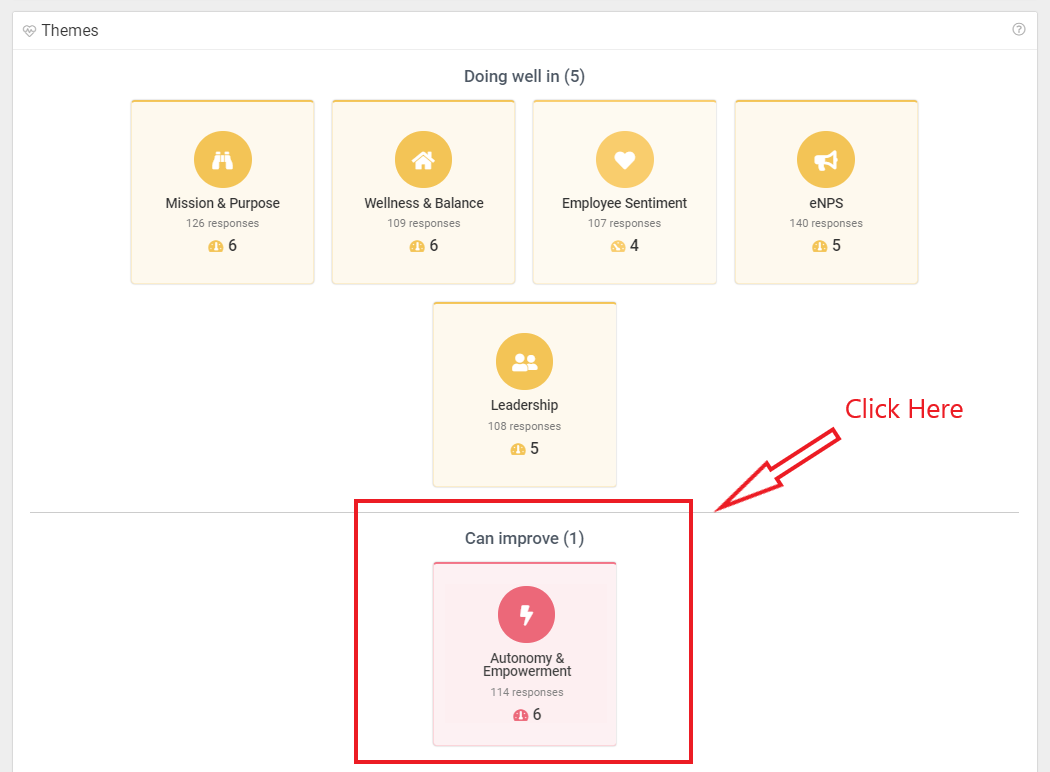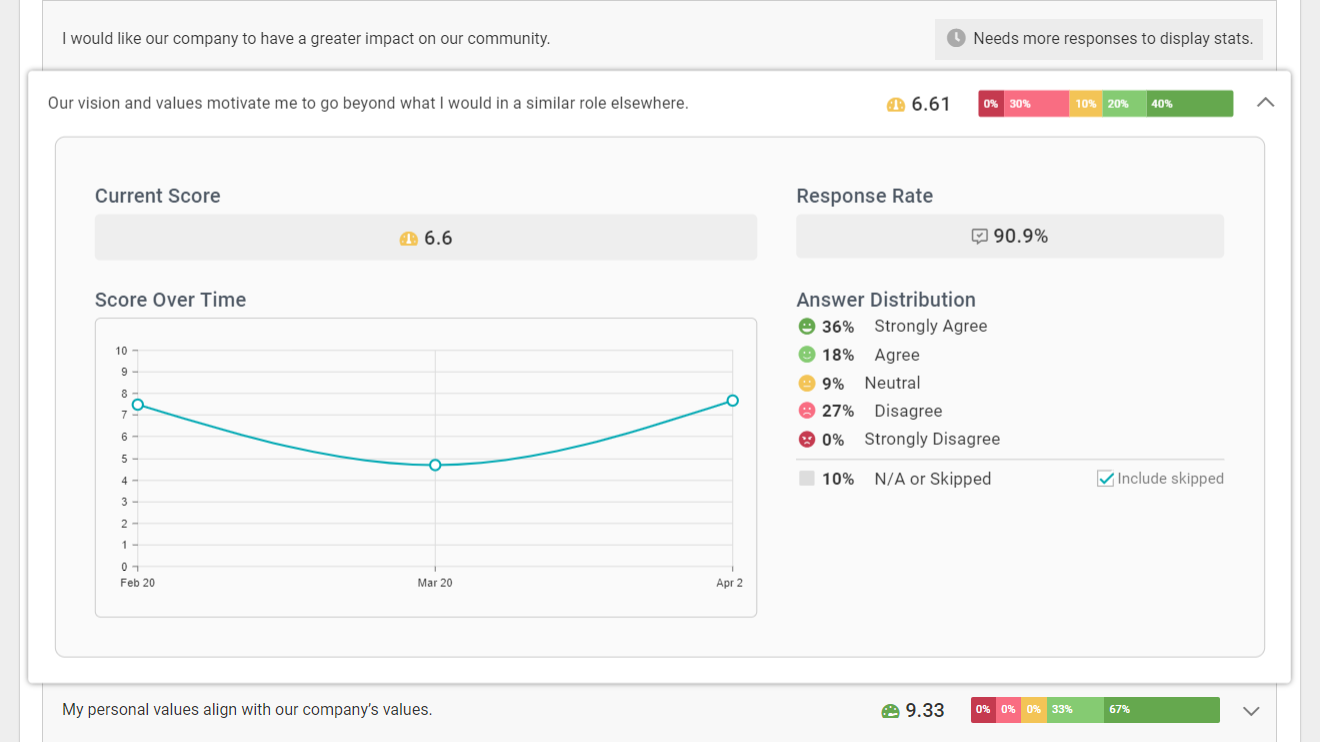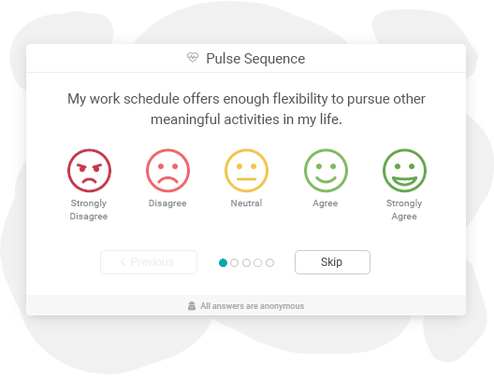If you've landed on this page, it's probably because you received a lower score on one of the Pulse Survey themes below.
That's ok!
Remember: When you measure employee engagement regularly, it's normal to see ebbs and flows. When it comes to the employee experience, it's rare to have a perfect score, and there is usually room for improvement. By surveying your employees to determine their pain points, be assured, that you are already taking the proper first steps.
- Career Growth
- Leadership
- Diversity & Belonging
- Wellness & Balance
- Recognition & Rewards
- Team & Communication
- Work & Performance
- Mission & Purpose
- Goals & Alignment
- Autonomy & Empowerment
- Benefits & Compensation
- Employee Sentiment
- Safety & Security
- eNPS
That said, Pulse Surveys are a great diagnostic tool. In other words, they tell you exactly where your employee experience might be lacking. However, the tool doesn't offer a way forward – in other words, how you can improve that specific theme.
Coming up with an action plan and taking the next steps is easier than you think. Let's start with a simple example.
Suppose you score low on "autonomy & empowerment." However, you might not know precisely why – or more importantly – what your employees need to feel happier in that area.
To improve that particular theme (or any theme flagged as "can improve"), we suggest that you complete the following steps:
- Dive deeper into the question breakdown for the theme in question.
- Gather employee feedback to understand the root cause of the issue.
- Educate yourself on best practices for improving that area of the employee experience.
Now, let's explore each step a little further...
This way, you will understand why each step matters and how this effort can lead you closer to improving the theme in question, and ultimately your company's performance.
Step 1 - Analyze the answer distribution for each question in the "problem" theme
With Pulse Survey results and dashboards, you can delve deeper into the results to gather more information.
By reviewing the answer distribution for each question, you can learn the following:
- Which specific questions are being skipped.
- Which specific questions have a low answer rate.
- Which specific questions yield low/high scores.
- Which specific questions yield mixed results.
Take, for example, an “autonomy & empowerment” theme that is consistently getting flagged “can improve” by the reports.

In this case, there is a persistent issue at hand. We recommend you click on that theme and view the more detailed data. The data will reveal which questions are consistently scored low.
- For instance, you might notice the question, “my manager trusts me and does not interfere with my work,” receiving significantly low scorer scores than others.
Below is an example of what the answer distribution data for each question looks like in Applauz Reports.

As you can see, this step is critical as it reveals valuable insight.
The detailed data provides a clearer picture of where and what employees are unhappy with. And in extension, what you can do to improve the situation.
Back to the example, from your analysis, it’s clear that employee-manager trust is likely low. In other words, micromanagement might be a problem that needs to be addressed.
That said, even after completing step one, you might also need to investigate the issue further. This can be especially true if all of the questions got similarly low scores, you are surprised by the results, or if you need to get a better idea of what your company's employees need to be happy.
This takes us to step number two.
Step 2 - Gather feedback from employees
If we continue from the example above, the response breakdown revealed that micromanagement might be a problem. Still, you are unsure of the severity or what to do to improve the situation.
At this point, we recommend speaking with your employees. By asking employees their opinions, you can create an action plan that speaks directly to their unique needs.
You can use the following methods to gather more information about the theme in question:
- Company Polls (anonymous).
- Anonymous short-form survey (using Google Forms or another free survey tool).
- Focus groups.
- 1:1 interviews.
Taking the time to confirm hypotheses such as "micromanagement is a problem" or determining how you can resolve the issue is a critical step. This step may seem time-consuming in the short term. Still, this work will be beneficial in the long run as it will give you the information you need to implement a viable solution. One that actually speaks to employees' needs and ultimately solves the problem.
Step 3 - Inform yourself (and your managers) on best practices
The best way to improve employee satisfaction is to assess the root cause of the issue and tailor your employee engagement strategy accordingly. Nonetheless, there are some best practices that you can use as well. These are universal principles that are likely to be effective for your organization.
With Applauz's blog, you will find a wealth of HR industry research, information and tips to improve employee satisfaction and engagement. For this section, we've hand-picked our best blog articles to help you improve each theme.
Note that some themes do not have content yet; we continually strive to develop our blog so HR professionals can address their most pressing concerns. We will update this list whenever new content is published!
That said, much of our content is for both managers and HR. So if you find the articles valuable, we recommend that you share some of this content with your company managers as well!

How to Improve your Pulse Survey Themes on Applauz
 Career Growth
Career Growth
Having inadequate chances for growth is one of the main reasons people leave their jobs. People want to feel challenged; it's human nature. And contrary to popular belief, this doesn't necessarily mean a new title or promotion.
Organizations and managers can stimulate motivation in a variety of ways through new challenges and learning opportunities. Ensuring that employees are being challenged and supported in their professional development is a critical component of keeping them motivated and engaged in the long term.
If your company scored low on this theme: It may be that your employees feel that your company doesn't provide enough professional development opportunities. Or it may be that employees feel as though they are not being challenged enough in their day-to-day responsibilities and duties.
 Leadership
Leadership
Effective leadership is a critical component of employee engagement. A positive work environment requires good management skills such as delegation and communication.
And we all know that the employee-manager relationship is central to retention and other long-term HR goals. The old adage "people don't leave jobs, they leave managers" holds true across industries.
If your company scored low on this theme: It's likely your managers aren't providing enough support to their teams or behaving in a way that hurts team morale and the working environment. It's important to understand exactly what your company's leadership can do to improve the situation.
On the Applauz blog, we offer content that helps managers and HR understand the traits of great leaders. And more importantly, what steps you can take to improve the quality of your company's leadership.
- Questions Managers Should Ask at One-on-One Meetings
- Top 9 Enduring Qualities of Great Managers
- 7 Mistakes New Managers Make That Impact Employee Engagement
- 9 Communication Mistakes That Hurt Employee Motivation
- 6 Dos and Don'ts of Managing Employees Who Work From Home
- 6 Simple Things Managers can say to Keep Employees Motivated
 Diversity & Belonging
Diversity & Belonging
To build diversity means ensuring that people of all backgrounds are included in your business. And most importantly, that they're represented at every level. While cultivating a sense of belonging is about making sure that everyone feels respected and included, regardless of background.
As such, promoting diversity and inclusion has proved to be incredibly beneficial for businesses. Ensuring all employees feel included and respected is critical. Research shows that creating more diversity in your workplace helps build a happier, more positive culture.
If your company scored low on this theme: It's likely that employees lack a sense of belonging and feel excluded from their teams or the company at large. Or they feel that your company doesn't treat everyone equally or with the same respect.
 Wellness & Balance
Wellness & Balance
Workplace well-being and wellness are hot-button issues. Burnout is on the rise across all industries. As such, supporting well-being has become an important strategy for employee retention and engagement.
However, how your company supports employee well-being should be unique and tailored to your employees' needs. For some businesses, this may mean better programs and resources to support mental health. In contrast, others may benefit from implementing new policies that help workers achieve better work-life balance.
If your company scored low on this theme: It's likely your employees feel overwhelmed, stressed, or burned out by the demands of their job. Most importantly, you need to understand why your employees are struggling and come up with tailored solutions.
Applauz's blog will help you learn some best practices and solutions for dealing with a stressed and burnt-out workforce. And what you can do to improve the well-being of your employees for the long term.
- How HR and Managers Can Work Together to Prevent Employee Burnout
- 21 Simple Tips for Managers to Support Employee Wellness Today
- 7 Signs of a Troubled Company Culture (And What to Do About It)
- 11 Research-Based Practices to Help Reduce Stress and Boost Well-being at Work
- 7 Simple Ways to Instantly Support Your Employees' Mental Health
 Recognition & Rewards
Recognition & Rewards
Everyone wants to be valued and appreciated. It’s a simple fact of human nature that just can’t be denied. Compensation (i.e. a pay raise) is only one method for companies to recognize their employees. What about every other day of the year?
Employers need to provide formal recognition for big accomplishments -- such as service awards, pay raises, and promotions. But employees also want to be recognized in more continuous ways, with timely recognition. In short, using both structured and unstructured recognition is the key to building a culture of recognition and appreciation.
If your company scored low on this theme: It's likely that your employees don't feel adequately recognized for their achievements. It could be that you have outdated rewards systems in place or that your managers simply don't give enough verbal support and appreciation. Don't worry; you are in luck – recognition is our specialty!
Applauz provides a wealth of content that helps HR and Managers learn about the importance of recognition. In addition, the blog includes articles about how to give more effective recognition.
For Managers
- 6 Simple Tips to Give Effective Recognition Using Recognition Software
- 7 Proven Tips for Managers to Give Better Recognition in the Workplace
- 31 Employee Appreciation and Recognition Message Examples
- 3 Easy Steps to Give Powerful Employee Recognition
- 9 Reasons to Give Employees Recognition (Other Than to Say Good Job)
- 4 Recognition Pitfalls Managers Should Be Aware Of (and How to Avoid Them)
For HR
- A Step-By-Step Guide to Plan an Employee Recognition and Rewards Strategy
- Applauz Book Club: Building a Strong Employee Recognition Program
 Mission & Purpose
Mission & Purpose
An inspiring company mission should be more than just about making profit. What kind of impact do you have on your industry and clients. How does your company make a difference?
For example, a mission focused on a business goal to become the "market leader" doesn't tell you very much about why your company is important or how you make a difference. Strong missions have a moral quality; they appeal to our emotions and inspire a sense of purpose. And as a result, they are especially effective at boosting long-term motivation.
If your company scored low on this theme: It's likely your company has not communicated an inspiring long-term mission and vision for the future. It's also possible that your company's impact on your industry or clients isn't meaningful enough, as such employees don't feel inspired.
Take a look at the content below for more information about establishing a clear mission and purpose for your company and how this relates to employee engagement.
- Applauz Book Club: Insights from Google That Will Transform Your HR Practices
- Applauz Book Club: How to Build a Deep Purpose Organization
 Goals & Alignment
Goals & Alignment
It's easy for employees to lose direction, enthusiasm, and productivity when goals are unclear or there is confusion about which goals have priority.
Ensuring Goals and alignment is the process of making sure that your people know what is expected of them. In short, teams are aligned, employees are aware of what has priority, and they are not being pulled in multiple directions.
If your company scored low on this theme: This can indicate that your employees are unclear on their short-term goals or their roles and responsibilities. As a result, productivity may suffer due to a lack of clarity about what needs to be done and what is expected.
To help you understand how to set better goals for employees and how you can use Applauz to do that, check out these articles on the Applauz blog.
- 6 Simple Ways to Better Employee Productivity
- How Applauz Goals Can Help Engage and Motivate Employees
 Autonomy & Empowerment
Autonomy & Empowerment
Empowerment and autonomy are two of the most critical aspects of engagement.
Sadly, many companies operate otherwise – only letting a few people hold all the power over decisions. In other words, employees are not given a say in the direction of their team or the company. This traditional top-down approach can profoundly impact employees' psychology and, ultimately, their engagement.
If your company scored low on this theme: Your organization might not be giving employees enough of a say in how they do their work or the direction of their teams. Or, your managers may have a tendency to micromanage and not give employees enough independence.
With our blog, you can learn how to harness the power of autonomy and empowerment to drive greater productivity and success for your company.
- How to Support Employee Autonomy and Boost Happiness in Your Company
- Applauz Book Club: Insights from Google That Will Transform Your HR Practices
- 6 Lessons about Motivating Employees I Learned as a Customer Service Manager
 Benefits & Compensation
Benefits & Compensation
Compensation is one of the most important forms of recognition. A strong pay strategy ensures the right external incentives are in place, and as a result, employees feel driven and motivated – but more importantly, valued and recognized for their efforts.
As such, a business will naturally experience higher engagement and productivity when employees feel fairly and adequately compensated.
If your company scored low on this theme: Your employees are likely unhappy with their compensation or benefits received. They might believe they are paid under the market standards or that they would leave for greater compensation.
 Employee Sentiment
Employee Sentiment
Keeping employees' spirits high is critical to employee engagement. When employees face repeated stressors at work, it's likely to colour their opinions of the work environment. This negative mindset can lead to low morale and even burnout.
A positive and pleasant work environment, on the other hand, tends to make one feel more psychologically safe and connected to the job. As a result, employees become more passionate and more driven, resulting in greater engagement.
If you received a low score here: Your company's morale and sentiment are likely low. People are not feeling good about coming to work. Cynism is likely high. It may be that the job demands are too high, and the environment is not appealing or lacks positive experiences.
Employee happiness is a topic we write about a lot, as employee happiness is so central to engagement. Make sure to check out some of the best practices for keeping employees happy. We have many resources for both managers and HR.
- 12 Simple Ways of Improving Employee Happiness
- 3 Signs Your Employees Are Disengaged (And How to Respond)
- Why Employee Happiness Is the New Engagement (And How You Can Cultivate It)
- What Is Employee Disengagement: 3 Personas
Safety & Security
The physical safety of employees in the workplace is a critical factor in their happiness and satisfaction with work.
When employees feel as though their physical safety is a priority they can be more focused, productive, and able to do their best work.
If your company scored low here: Your employees may feel that their physical safety is not a top priority. For example, they do not fully understand your company's safety protocols, or they may simply not feel comfortable and safe in and around your workplace.
 Team & Communication
Team & Communication
Our work relationships are paramount in shaping our experience at work. When employees feel a sense of safety and respect among their peers, this creates an environment where great work can be done.
While poor interpersonal experiences can severely impact the sentiment and mood of employees, and by extension, the performance of a team.
If your company scored low here: Your employees may be having interpersonal issues among their teams. There may be a lack of trust, cohesion, and psychological safety between employees causing them to feel a sense of disconnect from their team.
- Applauz Book Club: The Secrets of Highly Successful Groups
- 9 Communication Mistakes That Hurt Employee Motivation
- 6 Simple Things Managers can say to Keep Employees Motivated
 Work & Performance
Work & Performance
How do employees feel about their work and responsibilities?
Do they feel adequately challenged and do they feel like they have what they need to deliver quality work? These are important questions when considering the overall satisfaction of your employees and teams.
If your company scored low here: This could be a sign there is a mismatch between what an employee is expected to do and what they actually deliver with their skills and resources available to them.



